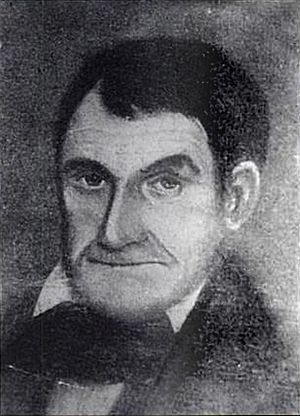Owen Brown (abolitionist, born 1771) facts for kids
Quick facts for kids
Owen Brown
|
|
|---|---|
 |
|
| Born | February 16, 1771 |
| Died | May 8, 1856 (aged 85) Hudson, Ohio, U.S.
|
| Resting place | Old Hudson Township Burying Ground |
| Other names | Squire Brown |
| Spouse(s) |
Ruth Mills
(m. 1793–1808)Sally Root
(m. 1809–1840)Lucy Hinsdale
(m. 1841–1856) |
| Children | 8, including John Brown |
| Relatives | Owen Brown (grandson) |
Owen Brown (February 16, 1771 – May 8, 1856), father of abolitionist John Brown, was a wealthy cattle breeder and land speculator who operated a successful tannery in Hudson, Ohio. He was also a stout and outspoken abolitionist and civil servant. Brown was a founder of multiple institutions including the Western Reserve Anti-Slavery Society, Western Reserve College, and the Free Congressional Church. Brown gave speeches advocating the immediate abolition of slavery and facilitated the Underground Railroad.
Someone whose father was an intimate friend of Owen remembered him as "a very kind, genial, whole-souled sort of person. He stuttered badly."
Owen wrote two brief autobiographic statements that have survived to the present.
Early life and education
One of 10 children, Owen Brown was born on February 16, 1771, to Revolutionary War Capt. John Brown (1728–1776) and Hanna Owen Brown, in Torrington, Connecticut. A lifetime admirer of the Founding Fathers, Owen's first memory was of the departure of his father's militia company to engage the British in New York during the summer of 1776.
Career
A wealthy tanner, cattle breeder, and land speculator, Brown was a dedicated civil servant and was integral to the early growth of Hudson, Ohio. Famed for his resourcefulness and energy, he was known locally as Squire Brown. He was the third wealthiest man in Hudson in the 1830s. Brown served in a multitude of positions in the community including County Commissioner and Justice of the Peace. Brown was deeply rooted in the abolitionist movement. He was personal friends with leaders such as Frederick Douglass, who often stayed with the Brown family when he was lecturing in the area. Owen, in collaboration with David Hudson, was integral in establishing one of the earliest way stations along the Underground Railroad, and personally arranged passage into Canada for many escaped slaves.
Colleges
Owen was a founding trustee of Western Reserve College and is credited for securing its location in Hudson as well as overseeing the construction of its first building. During Brown's tenure (1825-1835), Western Reserve College became known as a hotbed of abolitionist ideals. After the death of the institution's first president, Charles Backus Storrs, in 1833 the university elected a more conservative president, George E. Pierce, in an attempt to distance itself from the politics of slavery. In 1835 Brown resigned his position and joined a large contingency of faculty, staff, and students of Western Reserve College, who, together with one trustee, one professor, and a large number of students from Lane Theological Seminary in Cincinnati, in moving to Oberlin Collegiate Institute (since 1850, Oberlin College) in Oberlin, Ohio, where Owen served as trustee from 1835 to 1844. Brown and others were successful in making Oberlin the first institution of higher learning to admit women and one of the first to admit black students. Owen's own daughter, Florella Brown, studied at Oberlin from 1835 to 1839, where she met her husband, Samuel Lyle Adair.
Death and burial
Brown died in Hudson, Ohio on May 8, 1856 and was buried at Old Hudson Township Burying Ground.
See also

